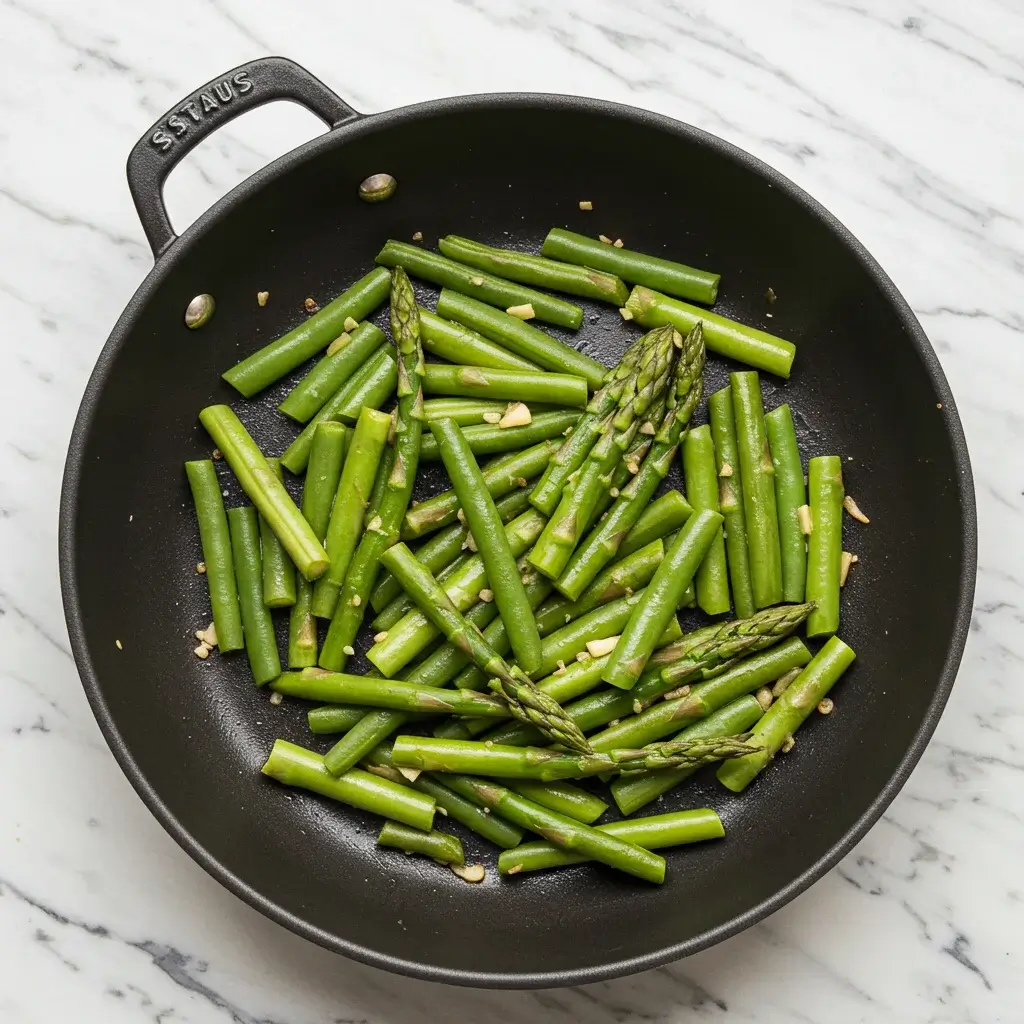Sautéed green beans and asparagus make for a delightful and healthy side dish that is perfect for any meal. This vibrant dish is not only quick and easy to prepare but also packed with nutrients and flavors that will elevate your dining experience. Whether you’re planning a family dinner or a festive gathering, this recipe will surely impress. Let’s dive into the details and explore how you can create this delicious dish right in your kitchen.
Ingredients
Before we get started, let’s take a look at the ingredients you’ll need for this recipe. Each component plays a crucial role in enhancing the dish’s flavor and nutritional value:
- 1 cup green beans, trimmed
- 1 cup asparagus, cut into 2-inch pieces
- 2 tablespoons olive oil
- 2 cloves garlic, minced
- Salt and pepper to taste
- 1 tablespoon lemon juice
- Optional: crushed red pepper flakes for heat
Instructions
Creating this vibrant dish is a breeze. Follow these simple steps to enjoy a plate of perfectly sautéed green beans and asparagus:
- Heat Olive Oil
Begin by heating the olive oil in a large skillet over medium heat. The oil serves as a base for sautéing the vegetables and infusing them with rich flavor. - Sauté Garlic
Add the minced garlic to the skillet and sauté for about 1 minute. Stir continuously to ensure the garlic becomes fragrant but does not burn. - Add Vegetables
Toss in the trimmed green beans and cut asparagus. Sauté them for 5-7 minutes until they reach a tender-crisp consistency. This technique will maintain their vibrant color and nutritional benefits. - Season and Flavor
Season the sautéed vegetables with salt, pepper, and lemon juice. If you prefer a bit of heat, sprinkle some crushed red pepper flakes. Stir everything together to ensure the flavors are well combined. - Serve Warm
Once the vegetables are perfectly cooked and seasoned, serve them warm. Enjoy the delicious medley of flavors and textures.
Nutrition Facts
Eating healthy doesn’t mean sacrificing taste. This sautéed green beans and asparagus recipe offers a nutritious profile that complements its delightful flavors. Here’s a closer look at the nutrition facts per serving:
- Calories: 120
- Protein: 3g
- Fat: 8g
- Carbohydrates: 10g
- Fiber: 4g
This dish is an excellent choice for those looking to enjoy a low-calorie, high-fiber meal that’s rich in vitamins and minerals.
How to Serve
Sautéed green beans and asparagus are versatile vegetables that can elevate a meal in numerous ways. Their vibrant colors and crisp textures not only enhance the visual appeal of a dish but also contribute essential nutrients. Here are some detailed suggestions on how to incorporate sautéed green beans and asparagus into your meals for a delicious and balanced dining experience:
As a Side Dish
Sautéed green beans and asparagus make an excellent side dish, complementing a wide range of main courses. When paired with roasted chicken, the bright, earthy flavors of the vegetables contrast beautifully with the savory, herb-infused meat, creating a harmonious balance on the plate. For those who prefer seafood, the crispness of the sautéed vegetables pairs exceptionally well with grilled salmon. The richness of the fish is lightened by the freshness of the green beans and asparagus, making for a satisfying meal. Additionally, serving these sautéed vegetables alongside a juicy steak enhances the dish’s overall flavor profile, providing a crunchy texture that contrasts with the tender meat. To elevate this combination, consider drizzling a balsamic reduction or a squeeze of lemon over the sautéed vegetables just before serving, adding an extra layer of flavor.
With Grains
Incorporating sautéed green beans and asparagus with grains is another fantastic way to create a wholesome dish. Serving them alongside quinoa not only enhances the meal’s nutritional value but also provides a delightful textural contrast. Quinoa is a complete protein, making it an excellent base for a plant-forward meal. You can toss the sautéed vegetables with the quinoa and add ingredients like cherry tomatoes, feta cheese, or a light vinaigrette to create a vibrant quinoa salad. Similarly, pairing these vegetables with brown rice adds a nutty flavor and a healthy dose of fiber, making it a filling option. Consider enhancing this combination with a splash of soy sauce or sesame oil to infuse the dish with Asian-inspired flavors. Lastly, couscous can be an ideal option for a quick meal; its fluffy texture complements the crisp vegetables perfectly. You can prepare a lemon-herb couscous and mix in the sautéed green beans and asparagus for a refreshing side that ties the meal together.
Topped on Salads
Adding sautéed green beans and asparagus to salads not only boosts their nutritional content but also introduces a delightful crunch. When included in a fresh salad, these sautéed vegetables can transform a simple dish into a gourmet experience. For a Mediterranean-inspired salad, combine them with mixed greens, olives, cherry tomatoes, and a sprinkle of feta cheese, drizzled with a lemon-oregano dressing. Alternatively, for a protein-packed option, toss them into a chickpea salad with tahini dressing, diced cucumbers, and red onion for a filling meal that is as nutritious as it is delicious. The warmth of the sautéed vegetables can also contrast nicely with cooler salad ingredients, creating a delightful mix of textures and temperatures.
In Wraps
Sautéed green beans and asparagus can be creatively used as a filling for wraps or sandwiches, adding a healthy crunch that enhances the overall flavor profile. For a quick lunch option, consider making a Mediterranean wrap by filling a whole grain tortilla with hummus, sautéed vegetables, roasted red peppers, and fresh spinach. The combination of flavors and textures makes for a satisfying meal that is easy to prepare and packed with nutrients. You can also create a protein-rich wrap by adding grilled chicken or tofu alongside the sautéed vegetables, providing a balanced meal that keeps you energized throughout the day. For a unique twist, try using the sautéed green beans and asparagus in a Vietnamese rice paper roll filled with fresh herbs, avocado, and shrimp or tofu, served with a zesty dipping sauce.
In conclusion, sautéed green beans and asparagus are not only versatile but also serve as a nutritious and flavorful addition to any meal. Whether served as a side dish, paired with grains, topped on salads, or used in wraps, these vibrant vegetables can enhance your dining experience and contribute to a balanced diet. With a little creativity, you can incorporate them into a variety of dishes, making healthy eating both enjoyable and satisfying.
Additional Tips
Cooking is not just about following a recipe; it’s a holistic experience that engages your senses and allows you to express your creativity. To elevate your culinary endeavors, consider these detailed tips that enhance flavor, texture, and overall enjoyment in your dishes.
Choosing Fresh Produce
The foundation of any great dish is high-quality ingredients, and when it comes to vegetables, freshness is key. When selecting green beans and asparagus, look for the following characteristics to ensure optimal flavor and texture:
- Vibrant Color: Fresh green beans should have a bright, vivid green hue, while asparagus should display a deep green color with a slight purplish tint at the tips. Avoid produce that appears dull or has yellowing spots, as these are indicators of age or poor quality.
- Crispness: Gently snap a green bean; it should break easily and cleanly, indicating freshness. Similarly, fresh asparagus should feel firm and slightly bend without wilting. If the stalks are limp, they may have lost their crisp texture and flavor.
- Seasonality: Whenever possible, choose seasonal produce, as it is often harvested at its peak ripeness, leading to enhanced flavor. For example, asparagus is typically in season during the spring, making it the best time to enjoy its tender, sweet taste.
- Local Sourcing: Consider shopping at local farmers’ markets or joining a community-supported agriculture (CSA) program. Freshly harvested produce often tastes better than store-bought items that have traveled long distances.
Adjusting the Heat
For those who crave a bit of spice in their meals, adjusting the heat level can significantly enhance the overall experience of a dish. Here’s how to do it effectively:
- Crushed Red Pepper Flakes: If you enjoy a kick, start with a small amount of crushed red pepper flakes and gradually increase until you reach your desired spiciness. Remember that the heat can intensify as the dish cooks, so it’s wise to err on the side of caution initially.
- Alternative Spicy Ingredients: Consider incorporating other spices or ingredients to add heat, such as diced jalapeños, serrano peppers, or even a dash of hot sauce. Each ingredient brings a unique flavor profile, allowing you to customize the heat to your liking.
- Balancing Flavors: While increasing spice levels can enhance your dish, it’s essential to maintain balance. Pair spiciness with sweet or acidic elements (like honey or lemon juice) to create a harmonious flavor that excites the palate without overwhelming it.
Adding Nuts
Incorporating nuts into your dishes can provide not only a delightful crunch but also additional layers of flavor and nutritional benefits. Here’s how to best utilize nuts in your cooking:
- Toasting: Always toast nuts before adding them to your dish. This process enhances their natural oils and brings out richer flavors. Simply place them in a dry skillet over medium heat, shaking frequently until they are golden brown and fragrant. This usually takes just a few minutes, so keep a close eye on them to prevent burning.
- Choosing the Right Nut: Different nuts offer unique flavors and textures. For instance, toasted almonds impart a mild, buttery taste, while walnuts provide a slightly bitter edge that can complement sweet or savory dishes. Experiment with various nuts to discover which pair best with your meal.
- Adding at the Right Time: Incorporate nuts towards the end of cooking or as a garnish to preserve their crunchiness. Adding them too early can result in a soggy texture, diminishing the pleasant crunch that enhances the overall dining experience.
Experiment with Herbs
Fresh herbs can transform a dish from ordinary to extraordinary. They not only add vibrant color but also introduce fresh, aromatic flavors that can elevate the entire meal. Here are some tips for using herbs effectively:
- Opt for Fresh Over Dried: Whenever possible, use fresh herbs. They are often more flavorful than their dried counterparts, and the vibrant green color adds visual appeal. For example, fresh parsley offers a bright, slightly peppery taste, while dill adds a distinctive, slightly tangy flavor that pairs beautifully with many dishes.
- Chopping Techniques: For maximum flavor release, chop herbs just before using them. This releases aromatic oils and enhances their fragrance. However, be careful not to over-chop; too much handling can bruise the leaves and diminish their flavor.
- Layering Flavors: Consider adding herbs at different stages of cooking. For instance, add heartier herbs like thyme or rosemary early in the cooking process to allow their flavors to infuse the dish, while more delicate herbs like basil or cilantro can be added at the end for a fresh burst of flavor.
- Herb Substitutions: Don’t hesitate to experiment with different herbs based on personal preference or availability. For example, if a recipe calls for thyme, oregano can often serve as a suitable substitute, offering a different yet complementary flavor profile.
By incorporating these tips into your cooking routine, you can significantly enhance your culinary creations, leading to meals that are not only flavorful but also visually appealing and satisfying. Embrace the journey of cooking, and enjoy the process of discovering new tastes and textures that can elevate your dishes to new heights.
FAQs
Q: Can I use frozen vegetables for this recipe?
A: Yes, you can use frozen green beans and asparagus. However, fresh vegetables will provide a better texture and flavor.
Q: How can I make this dish vegan?
A: The recipe is already vegan, as it uses olive oil and does not contain any animal products.
Q: What can I substitute for lemon juice?
A: If you don’t have lemon juice, you can use apple cider vinegar or white wine vinegar for a similar tangy flavor.
Q: How do I store leftovers?
A: Store any leftovers in an airtight container in the refrigerator for up to 3 days. Reheat them gently in a skillet or microwave before serving.
Q: Can I add other vegetables to this dish?
A: Absolutely! Feel free to add other vegetables like bell peppers, mushrooms, or cherry tomatoes for added variety and nutrition.
Conclusion
Sautéed green beans and asparagus are not only simple to prepare but also incredibly flavorful and nutritious. This dish is a testament to how fresh ingredients, when combined with the right seasonings, can create a culinary masterpiece. Whether you’re serving it as a side dish or incorporating it into a larger meal, these sautéed vegetables will delight your taste buds and nourish your body. Enjoy the vibrant colors and fresh flavors as you savor each bite of this delicious recipe.
Print
Sautéed Green Beans and Asparagus Recipe
Ingredients
- 1 cup green beans, trimmed
- 1 cup asparagus, cut into 2-inch pieces
- 2 tablespoons olive oil
- 2 cloves garlic, minced
- Salt and pepper to taste
- 1 tablespoon lemon juice
- Optional: crushed red pepper flakes for heat
Instructions
- Heat Olive Oil
Begin by heating the olive oil in a large skillet over medium heat. The oil serves as a base for sautéing the vegetables and infusing them with rich flavor. - Sauté Garlic
Add the minced garlic to the skillet and sauté for about 1 minute. Stir continuously to ensure the garlic becomes fragrant but does not burn. - Add Vegetables
Toss in the trimmed green beans and cut asparagus. Sauté them for 5-7 minutes until they reach a tender-crisp consistency. This technique will maintain their vibrant color and nutritional benefits. - Season and Flavor
Season the sautéed vegetables with salt, pepper, and lemon juice. If you prefer a bit of heat, sprinkle some crushed red pepper flakes. Stir everything together to ensure the flavors are well combined. - Serve Warm
Once the vegetables are perfectly cooked and seasoned, serve them warm. Enjoy the delicious medley of flavors and textures.
Nutrition
- Serving Size: one normal portion
- Calories: 120
- Fat: 8g
- Carbohydrates: 10g
- Fiber: 4g
- Protein: 3g





